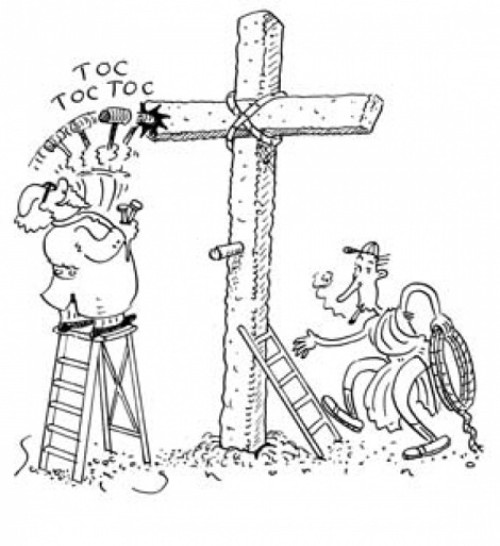Probably all of the above and then some. The suggested causes of death are all over the place, but so were the real causes, likely as not.
Those hoping for a just-the-facts account of crucifixion may be disappointed to learn that most of what we know comes from the gospels (including the extracanonical Gospel of Peter, rediscovered in 1886) or early Christian commentators. Though hundreds of thousands were crucified back then, pagan writers provide few details, considering crucifixion a shameful method of execution reserved for slaves and non-Romans. Christian descriptions of Jesus’s execution aren’t entirely reliable even if we neglect the supernatural angle—the gospels don’t always agree, and some details in Matthew and to a lesser extent John may have been tailored to make Jesus’s death appear to fulfill biblical prophecy. Still, these folks were writing when crucifixion was common, and while they may have taken liberties, nobody would have bought their story if they’d just made the technical details up.
In a standard Roman crucifixion, the naked victim was scourged with a whip, its multiple lashes often weighted with bone or metal. Scourging alone could be fatal but usually wasn’t. The crucificado was then nailed or tied to the crossbeam (not the whole cross) and forced to carry it to the permanently fixed upright. Blood loss from scourging and nailing helped determine survival time; the tied and lightly scourged could survive for days. In any case, victims suffered a long time before falling into prolonged unconsciousness and death. Soldiers typically didn’t hasten things along because long and painful was the point. Usually the victim remained on the cross until birds and beasts consumed the body, but to avoid complaints the Romans allowed some crucified Jews to be buried, as evidenced by a crucified-but-buried skeleton discovered near Jerusalem.
Lots of ways have been suggested for how this grisly process might kill you: exhaustion, exposure, heart failure, blood clot, pulmonary embolism, acidosis (the body’s pH going badly out of whack), hypovolemic shock (organ failure resulting from drop in blood volume, due either to dehydration or bleeding), arrhythmia, hemothorax or hemopneumothorax (accumulation of blood and air around the lungs) leading to lung collapse. Chances are the cause of death varied depending on circumstances. The thing is, once you realize crucifixion is supposed to be slow, the exact mechanism of death doesn’t seem so important. Obviously if you leave a guy exposed to the elements long enough he’ll die of something—starvation, if nothing else. Some believe animal scavengers killed the victims, plausible if you recall that the crosses were usually quite short.
The more interesting question is how crucifixion could kill somebody quickly—say, in three or six hours, as it’s said to have done in Jesus’s case. The best-known explanation is the asphyxia theory, popularized by the French physician Pierre Barbet in the 1950s. It goes like this: Tension in the breathing muscles prevents the victim from exhaling efficiently while hanging. He must continually push himself up to breathe. That’s impossible if someone’s broken your legs, which is what the soldiers supposedly did to the thieves crucified with Jesus to hasten their demise. For the theory to work, the “seat” (commonly a wooden peg at crotch level) would have to be removed and the victim left to hang with his arms nearly straight up and down. Support for this scenario comes from accounts of Dachau prisoners murdered this way, plus some nonfatal experiments.
The asphyxia theory has its critics. In the 1980s American pathologist Frederick Zugibe tested volunteers with their arms at more realistic angles of 60 to 70 degrees from the vertical. With less tension in the trunk, they breathed well even without pushing up. Zugibe thought the breaking of the victim’s legs was the coup de grace, intended to cause death by “cardiac and respiratory arrest due to hypovolemic and traumatic shock.” I’m not persuaded—for one thing, Zugibe puts a lot of credence in the discredited Shroud of Turin (though the shroud doesn’t directly bear on this point). More important, his volunteers had their feet strapped to the cross, and if we may judge from a photo of the setup, their legs surely bore some weight; he didn’t break anybody’s bones; and his longest experiment lasted only 45 minutes. His explanation of leg breaking seems contrived—if you want to finish someone off, there are many more effective ways to do it. Hastening asphyxiation seems a more likely motive, although it’s not something anyone’s going to want to confirm experimentally. In any case, let’s not forget that Jesus’s legs weren’t broken—he was already dead, most likely due to blood loss or other sequelae of severe scourging. No doubt crucifixion buffs will continue to debate, but I doubt we’ll ever get a more definitive answer than that.
Comments, questions? Take it up with Cecil on the Straight Dope Message Board, StraightDope.com, or write him at the Chicago Reader, 11 E. Illinois, Chicago 60611.
More by Cecil Adams
-
This Is the End, My Friend
This week's Straight Dope marks the last appearance of the column as the Teeming Millions have known it for the past 45 years.
- Jul 11, 2018
-
Do Brain Supplements Do Anything?
Brain Drain
- Jul 4, 2018
-
Is flying really worse for the environment than driving?
Planes and Trains
- Jun 27, 2018
- More »




